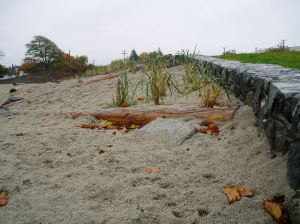
(photo by SVSeekins)

(photo by SVSeekins)
Don’t you just love Before & After photos? I do! I lose appreciation when measuring small day-to-day changes. Progress is so much more apparent when distanced by time.
That’s why I’m excited to compare the changes of the Fisherman’s Wharf Park after its 1st birthday.
When I originally visited the newly renovated park, I was charmed by the landscape architecture. A flat field had morphed into undulating hills & lovely ponds. Pretty.

photo by SVSeekins

photo by SVSeekins
Careful plant selections of natives & non-local species provide potential for a low maintenance park.
As any new transplants need regular watering until established, Victoria Parks department installed irrigation into the beds.
The plants, trees & shrubs prospered. The water requirements will diminish as the beds mature.
The holding pond of the rain garden is coming into its own.

(photo by SVSeekins)

(photo by SVSeekins)
For the past year, rain has been redirected from the neighboring parking lots & streets, and into the catchment pond.
Check out the height of the drain. It shows how deep the pond will get before overflowing into the storm drain system. Any standing water is filtered by the rain garden. It returns to the natural water table, instead of being sent to out to sea.
These plants / filters sure don’t look any worse for wear, considering they clean up any of the runoff’s pollutants. Isn’t science & nature groovy?

(photo by SVSeekins)

(photo by SVSeekins)
I’m not convinced the sandy beach is really what was here before Fisherman’s Wharf took over the area, but it’s a nifty idea. Can’t you imagine leaning your back against a big log & reading a good book?
It’s looking much more natural to me now. Sunshine & warm sand will be calling to me this summer. No doubt I’ll have to arrive early to get a spot.
-30-
© SVSeekins, 2014













